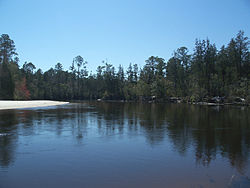By drainage basin
Atlantic coast




Rivers are listed as they enter the ocean from north to south. Tributaries are listed as they enter their main stem from downstream to upstream.
- St. Marys River
- Nassau River
- Fort George River
- St. Johns River – Juniper Springs, Salt Springs, Silver Glen Springs, Alexander Springs, Blue Spring, Beecher Spring
- Pablo Creek
- Sisters Creek
- Broward River
- Trout River
- Arlington River
- Ortega River
- Doctors Lake
- Julington Creek
- Black Creek
- North Fork Black Creek
- Lake Kingsley
- Yellow Water Creek
- South Fork Black Creek
- North Fork Black Creek
- Rice Creek
- Dunns Creek
- Ocklawaha River
- Orange Creek
- Little Orange Creek
- Orange Lake
- Cross Creek
- Prairie Creek-Camp Canal-River Styx
- Silver River
- Lake Griffin
- Yale Canal
- Lake Yale
- Haines Creek
- Lake Eustis
- Dora Canal
- Lake Dora
- Lake Beauclair
- Apopka-Beauclair Canal
- Lake Beauclair
- Lake Dora
- Dead River
- Dora Canal
- Lake Eustis
- Orange Creek
- Salt Springs River
- Alexander Springs Creek
- Hontoon Dead River
- Wekiva River – Wekiwa Springs
- Lake Jesup
- Econlockhatchee River
- Matanzas River
- Halifax River
- Indian River North
- Indian River
- St. Lucie River
- Loxahatchee River
- Hillsboro River
- Stranahan River
- Oleta River
- Little River
- Miami River
- Snapper Creek
Alachua Sink
Water enters Paynes Prairie Basin from a number of sources. Historically it drained only into Alachua Sink. Water entering the Alachua Sink flows into the Floridan aquifer. [2] (Various sources stating that water entering the Alachua Sink flows to the Santa Fe River may be based on a story told by a Seminole guide to a white explorer in 1823, that a Seminole who had drowned in the sink was later found in the river. [3] ) In 1927, Camps Canal was built, which linked the basin to the Orange Lake through the River Styx and ultimately to the Atlantic Ocean.
- Bivens Arm
- Tumbling Creek
- Little Tumbling Creek
- Sweetwater Branch
- Prairie Creek
- Newnans Lake
- Hatchet Creek
- Lake Forest Creek
- Little Hatchet Creek
- Newnans Lake
- Chacala Run
- Chacala Pond
- Sawgrass Run
- Sawgrass Pond
- Lake Wauburg
- Georges Pond
- Burnt Pond
- Georges Pond
- Lake Wauburg
- Sawgrass Pond
- Sawgrass Run
- Chacala Pond
- Dog Branch
Lake Okeechobee
Lake Okeechobee drains into the Atlantic Ocean via the St. Lucie River, the West Palm Beach Canal, the Hillsboro Canal, the North New River Canal, and the Miami Canal, and into the Gulf of Mexico via the Caloosahatchee Canal which connects to the head of the Caloosahatchee River. The major input of water into Lake Okeechobee comes from the north, via the Kissimmee River. Rivers are listed as they enter Lake Okeechobee from west to east. Tributaries are listed as they enter their main stem from downstream to upstream.
Gulf coast




Rivers are listed as they enter the gulf from south to north, then west. Tributaries are listed as they enter their main stem from downstream to upstream.
- Joe River
- Shark River
- Harney River
- Broad River
- Rodgers River
- Lostmans River
- Chatham River
- Huston River
- Lopez River
- New River in Collier County
- Turner River
- Barron River
- Fakahatchee River
- Whitney River
- Big Marco River
- Henderson Creek
- Cocohatchee River
- Imperial River
- Estero River
- Caloosahatchee River
- Peace River
- Myakka River
- Manatee River
- Little Manatee River
- Alafia River – Buckhorn Spring, Lithia Springs
- Palm River
- Hillsborough River – Crystal Springs
- New River in Pasco County
- Anclote River
- Pithlachascotee River
- Weeki Wachee River – Weeki Wachee Springs
- Chassahowitzka River
- Homosassa River – Homosassa Springs
- Crystal River
- Withlacoochee River (central Florida)
- Waccasassa River
- Suwannee River – Suwannee Springs, Hart Springs, Ginnie Springs, Fanning Springs, Manatee Springs, Otter Springs, Troy Spring
- Steinhatchee River
- Fenholloway River
- Econfina River
- Aucilla River – Nutall Rise
- Wacissa River – Wacissa Springs, Aucilla Spring,
- Pinhook River
- St. Marks River – St. Marks Spring
- Ochlockonee River
- Crooked River
- Carrabelle River
- Apalachicola River
- Jackson River
- Chipola River – Baltzell Spring, Blue Hole Spring
- Chattahoochee River
- Econfina Creek
- Choctawhatchee River – Vortex Spring
- East Bay River
- Yellow River
- Blackwater River
- Escambia River
- Perdido River
